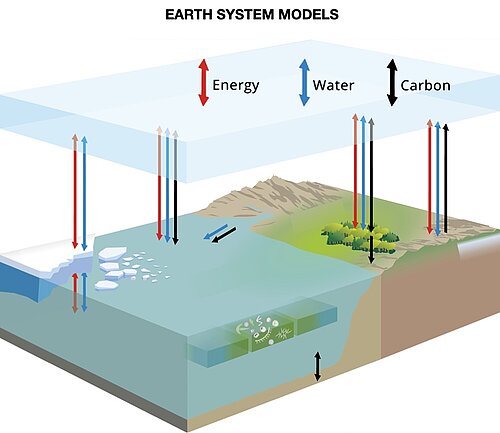Earth system sciences
The climate on planet Earth is a complex, interacting system. For instance, (natural and human-made) radiative forcing interacts with the global carbon cycle and the planet’s heat balance. The fragility of the Earth system's dynamics has become particularly evident as human activities increasingly disrupt Earth's balance, making humanity a significant force with a tangible impact. To understand Earth as a whole and contribute effectively to addressing the global challenges of climate change, a holistic research approach is essential. With a focus on ambitious climate change mitigation scenarios, the research group addresses a key question: How does the Earth system respond if we achieve our climate goals?
Research themes
Zero Emissions Commitment
What are the key processes in the Earth system that determine its response to halting CO2 emissions?
The zero emissions commitment (ZEC) describes the committed temperature change after anthropogenic emissions cease. It is an intrinsic feature of the Earth’s climate system due to slow and fast equilibration processes and has been shown to depend on the cumulative amount of CO2 emitted prior to zero (carbon emissions budget) and the state of the Earth system at the point of zero emissions. This state dependency can be described as the balance between the biogeochemical and thermal equilibration processes of the Earth system.
There remains substantial uncertainty and disagreement about the sign and size of temperature change after a cessation of CO2 emissions between different models. The inter-model range of ZEC 50 years after emissions cease (ZEC50) for a scenario with a cumulative carbon budget of 1000 PgC was found to be -0.36oC to 0.29oC with a model ensemble mean of -0.06oC. This magnitude of uncertainty implies that ZEC may be the largest contributor to the uncertainty on the remaining emissions budget for 1.5oC.
If ZEC were positive, it could reduce the budget by over a third and imply that net-negative emissions might be needed for temperature stabilisation. However, if ZEC were negative, that might even mean that sustained CO2 emissions could be allowable for a temperature stabilisation goal.

Ambitious mitigation scenarios
Ambitious climate change mitigation scenarios present current Earth system models (ESMs) with new challenges. In such scenarios with reduced anthropogenic CO2 emissions, the relevance of smaller climate signals of previously secondary processes become more important, since every tenth of a degree of warming counts. This means accurate representation of the climate-carbon interactions and feedback uncertainties including explicit Carbon Dioxide Removal (CDR) measures is needed. ESMs in an emission-driven configuration must be able to reproduce anthropogenic carbon emissions from fossil fuels and land use change and management in the context of a closed and stable carbon cycle, with accurate representations of natural and anthropogenic carbon sinks.
![[Translate to English:] sketch of marine carbon dioxide removal methods](/fileadmin/_processed_/2/e/csm_mCDR_d40d4b15ba.jpeg)
Carbon Dioxide Removal
Even if ambitious climate change mitigation measures aiming for a net-zero greenhouse gas (GHG) target are implemented, it is expected that humanity will continue to emit residual amounts of carbon dioxide and other GHGs, which will further drive global warming.
Options for carbon dioxide removal (CDR) – such as bioenergy combined with carbon capture and storage in geological formations, increasing the alkalinity of the oceans, or managing and expanding ecosystems – provide opportunities to support emission reduction efforts and offset remaining GHG emissions, making net-zero targets achievable. Furthermore, CDR is crucial for achieving net-negative emissions, which can reduce atmospheric CO2 concentrations and neutralize any overshoot of the carbon emissions budget or global temperature thresholds.
Methods

Methods
Our group aims to deepen our understanding of the Earth system's response to net-zero and overshoot scenarios, as well as to human activities like carbon dioxide removal (CDR). To achieve this, we utilize Earth system models of varying complexity (FOCI, UVic ESCM 2.9 & 2.10, along with multi-model ensembles from CMIP (CDRMIP, ZECMIP). Additionally, we contribute to comprehensive assessments of CDR options through interdisciplinary collaboration.
Our main research focuses include:
- Evaluating uncertainties and process understanding of net-zero and overshoot scenarios in relation to the carbon cycle and climate dynamics (FOOTPRINTS, RESCUE)
- Conducting model studies to understand the potential and risks of (marine) CDR options, including increasing ocean alkalinity, managing, and expanding blue carbon ecosystems (RESCUE)
- Performing comprehensive, transdisciplinary assessments of (marine) CDR options (CDRmare consortium ASMASYS, GESAMP WG41)
Team members
- Nadine Mengis: Works on comprehensive assessment frameworks for CO2 removal measures in the German context, with a focus on net-zero options for Germany. She quantifies uncertainties in temperature response to net-zero and overshoot scenarios, incorporating socio-economic and Earth system dynamic uncertainties (FOOTPRINTS [Project Lead], ASMASYS [Project Lead], RESCUE, GESAMP WG41, Co-Chair of CDRmare).
- David Hohn: Analyzes multi-model ensembles of zero-emission scenarios to determine the extent and uncertainty of the "Zero Emission Commitment" (ZEC) (FOOTPRINTS).
- Giang Tran: Works on evaluating the effectiveness, parametric uncertainties, and potential side effects of CO2 removal measures (CDR) in mitigating the impacts of climate change on marine ecosystems (RESCUE).
- Estela Monteiro: Investigates climate and temperature stabilization scenarios, with a focus on the contribution of non-CO2 emissions (FOOTPRINTS).
- Makcim De Sisto
- Judith Matz
- Sabine Bischof
- Tabea Rahm
- Judith Ziegler
- Ulrike Bernitt
- Michael Sswat



